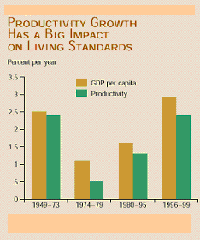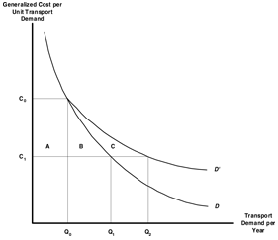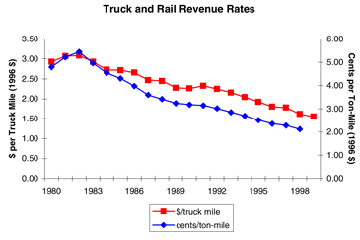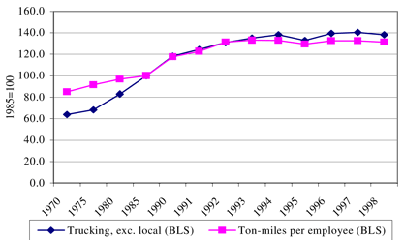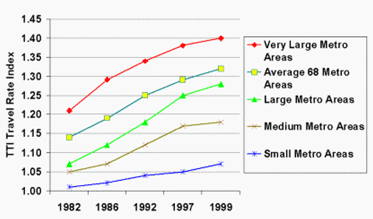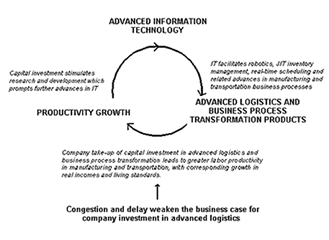Appendix A
Economic Effects of Transportation: The Freight Story
Final Report
Prepared by
ICF Consulting
9300 Lee Highway
Fairfax, VA 22031
HLB Decision-Economics
8403 Colesville Road
Silver Spring, MD 20910
January 2002
Table of Contents
- Freight Transportation and the Economy: A Description of the Linkages
- Trends in Freight Transportation
- Future Growth in Freight Transportation: the Role of Public Policy
Summary
This report describes the linkages between freight transportation and the economy. It is written with a broad audience in mind—an audience that is comprised predominantly of non-economists. It draws on the technical concepts that have been constructed under the Freight Benefit-Cost Analysis (BCA) Study that is being sponsored by the Federal Highway Administration (FHWA)—see the adjacent exhibit.1
Improvements in freight carriage can be expected to have important economic effects. Lower costs or better service, or both, in freight movement have a positive effect on all firms engaged in the production, distribution, trade and/or retail sale of physical goods. Reducing the per-mile cost of goods carriage means that any production or distribution facility can serve a wider market area, with potential gains from scale efficiencies. It also means a factory can draw supplies from a wider area with potential gains in terms of the cost and/or quality of parts and materials coming to the factory.
Managers of businesses are paying ever closer attention to efficiency in goods movement and tighter control of inventory and the whole supply chain. Logistics costs comprise transportation costs, costs of owning and operating warehouses, ordering costs, and carrying costs of inventory (principally interest and insurance). In recent years, trucking costs have been falling and reliability has been improving. Businesses have tended to respond by buying more transportation and using it to reduce the other components of logistics costs (e.g., through fewer warehouses or lower inventories). As we shall see, the tendency of managers to respond this way to lower costs and/or improved quality of freight transportation is a fundamental source of the economic benefits stemming from improvements in the freight transportation system.
This report describes how an efficient and reliable freight transportation system helps to generate improvements in economic productivity. Using findings from FHWA’s Freight BCA Study, the underlying linkages between freight transport and the economy are reviewed first. Then, the types of factors that drive the efficiency and reliability of freight transportation are discussed. Emphasis is placed on events that have led to significant improvements in truck and rail transport—events that have provided the foundation for the benefits that can be generated via business reorganization. Finally, the detrimental effects of worsening congestion on the productivity of the freight system are reviewed. The speed and reliability of the freight system can be expected to worsen as vehicle traffic grows and congestion increases. Such a development could force shippers and carriers into costly redesign and restructuring of their systems with higher logistics costs and a consequent drop in productivity. Improvement in the performance of the freight system, with concomitant gains in national productivity, will require significant gains in the battle against congestion.
FHWA’s Freight BCA Study
The goal of the Freight BCA Study—which is being conducted by ICF Consulting and HLB Decision-Economics under subcontract to AECOM—is to develop a benefit-cost analysis framework that captures the full extent of the economic impacts of changes to the freight transportation system, including benefits associated with business reorganization. To date, FHWA’s Freight BCA Study has included the following.
- A comprehensive review of literature on the economic impacts of transportation investments, covering over 170 articles, books, reports, and/or papers on the subject. The product of this component is a “Compilation of the Literature” report that describes the salient findings most relevant to freight transportation.
- The development of a microeconomic framework for assessing the comprehensive impacts of changes in the freight system. The framework is presented in a White Paper titled “Benefit-Cost Analysis of Highway Improvements in Relation to Freight Transportation: Microeconomic Framework”. The framework is briefly described in this report (at the end of Section 1).
- A report that 1) describes the linkages between freight transport improvements and economic productivity and 2) presents the microeconomic framework in a manner that is accessible to non-economists
- A meta-analysis of the relationship between logistics costs and freight transportation demand. The purpose of the meta-analysis is to support the application of the microeconomic framework by producing single estimates of elasticities that characterize dynamic economic interactions between demand and costs in a road freight transportation system.
1. Freight Transportation and the Economy: A Description of the Linkages
The American economy can grow and deliver improved living standards through one of two means, more workers or more productivity. With an aging population and net birth rates in decline, the nation is heavily dependent on productivity growth to achieve its economic goals. Transportation investment is important because its principal influence is on productivity.
Exhibit 1 illustrates how investments in transportation infrastructure can lead to generative effects2 and growth in the national economy. Although improvements in passenger transportation have important economic ramifications, freight transportation enhancements that reduce the costs of moving goods (and services) to and from markets are critical to economic expansion. This is because the movement of goods is what economists term a factor input in the production of goods. Much like labor and capital, transportation costs affect directly the price of goods and services and the profits of producers. Consequently, investments that reduce the cost of moving goods to and from markets (via improvements in reliability, transit times, service levels, etc.) can help to increase and sustain economic growth. In effect, the efficiency and reliability of the freight transportation system affects economic productivity, and many economists would argue that productivity is the most important determinant of economic performance.
Exhibit 1: Transportation and the Economy
1.1 Overview of Linkages
Improved freight transportation systems reduce costs for delivery of goods and services; they also support faster, more reliable transportation from one place to another. These, in turn, reduce the costs of collecting inputs and delivering products to markets in several ways: less driver time on the road thus lower labor costs; increased trip miles per time period per vehicle and thus smaller vehicle fleet needed for the same amount of work (“freight efficiency”); lower vehicle repair and operating costs; and improved transportation reliability.
The first three work directly to reduce total product costs. Improved transportation reliability works to reduce production costs via reductions in inventories of inputs, spare parts, and/or finished goods.
Cost reductions that are realized enhance the competitive position of enterprises with access to the improved freight facility or system. Expanded demand can generate economies of scale and improved productivity as enterprises take advantage of these market opportunities—thus inducing another round of cost reduction.
Beyond lower dollar costs to shippers, reductions in transit time and/or increases in schedule reliability can be expected to also have significant impacts. These gains in terms of time allow firms to manage their inventories and supply chains more efficiently. Increased reliability, for example, reduces the requirement for “buffer” stocks, inventory held to protect against delivery failure. Lower transit times reduce some costs (e.g., drivers’ wages for a given trip length). Further, as with lower dollar costs, less time for a move extends the “reach” of a factory or warehouse.
Exhibit 2: The logistics director of a national specialty retailer described this issue. He said he preferred to restock fast-moving goods on a next-day basis to make more space available for other products. But he said transportation cost kept him from doing this unless the stock turned over fast enough to justify truckload shipments. Otherwise, the higher transportation cost means a narrower, less attractive product range in a store
In this manner, better freight movement lets a firm serve customers better or at lower cost or both. One example is the variety of products that can be stocked in a retail store. The more space that is required to maintain inventory of fast-moving items, the less space there is available for items that turn over at a lower rate. Yet a wider product line is more attractive to customers. The more frequently the fast-moving items can be replenished, the more space is available for slower-moving items. And frequency of replenishment depends, in part, on transport costs (see Exhibit 2 directly above).
Improvements in the freight transportation system have made it possible for innovative producers to provide a high level of service to retail customers while holding inventories at low levels. One of the best examples of this is the system of on-line ordering of custom configured computers combined with just-in-time (JIT) delivery of components and tight control of inventory developed by Dell Computer (see Exhibit 3). The JIT system provides a high level of customer service with a dramatic reduction in inventory levels and costs.
Exhibit 3: Dell Computer on-line sales of custom-made computers—In 1996 Dell Computer launched its “on-line” store. Customers use the Internet to order computers made to their own specifications. Upon receipt, an on-line order is broken down to individual components. Components are either ordered for JIT delivery on very short notice or drawn from small stocks that are replenished on a JIT basis. From receipt of order to shipping the assembled computer with software loaded and tested takes about 36 hours. The JIT parts system allowed Dell to reduce parts inventory from an industry norm of 75 to 100 days to 6.6 days.
Innovation like JIT would not be possible without a combination of quality freight transportation services with sophisticated electronic communications systems. Improvements in these areas have impacted positively our standard of living and strengthened our economy by extending and improving the reach of businesses to markets and supplies.
1.2 Improvements in Logistics and Effects on Industry Productivity
From the discussion above, we see that it is not just a longer reach to supplies and markets that matters but also a better reach. As freight transport becomes faster and more reliable, hence more predictable, the flow of goods and the stocking of goods can be managed more efficiently. In other words, we see improvement in logistics. These improvements can increase productivity in manufacturing and distribution in many ways, and productivity improvements affect the economy (see Exhibit 4).
Exhibit 4: Productivity and Economic Performance—Productivity growth is important because it is the main determinant of changes in our standard of living. Note how growth in Gross Domestic Product (GDP) per capita tends to rise and fall in conjunction with growth in labor productivity.
As a technical concept in economic theory, productivity has more than one definition. But all the definitions embrace, one way or another, the notion of getting more output, or product, from available resources. An increase in productivity reflects more efficient use of the labor, capital, materials, and so forth that are available to society at any given time. Production can always be increased if more resources can be found, but the supply of resources at any particular time is always limited. Productivity gains allow us to enjoy more or better goods and services with the resources we have.
Improvement in logistics is about improvement in transportation and about more efficient management of inventory. Customers expect many kinds of goods to be available when they want them. When a person walks into a store or calls a catalogue house, that person wants to get the desired item and walk away with it or be assured by the catalogue company that it will be sent on the way directly. If the item is not in stock, both the retailer and the customer have a problem. The customer has to go to another store, or come back another time on an extra trip, or be told the item is on back order. Either way, the customer accepts a delay, goes to another retailer, or chooses something other than the preferred item. The retailer loses business. The same model applies to businesses buying supplies; it is costly to a business if it cannot obtain supplies when needed.
Businesses deal with this problem by carrying inventory. The whole purpose of holding inventory is to lower the probability that a firm will have to turn away a buyer for lack of stock or have to stop production for lack of parts or other supplies. But inventory is costly. Capital must be used to hold it, warehouse or store space has to be used to store it, and insurance must be carried to cover the risk of loss or damage. All of these costs are reduced if inventory can be reduced. Inventory held in retail stores or warehouses can be reduced if replenishment is fast and reliable.
For manufacturers and distributors of goods, there is a constant tension between the pressure to have enough stock to satisfy customers and the pressure to reduce the cost of carrying inventory. Businesses often find that improved freight transportation provides a way to accommodate these conflicting pressures. And, when inventory costs can be reduced while maintaining or improving the level of customer service, that is an increase in productivity.
In many cases, firms actually find that spending more on transportation is profitable because there are offsetting reductions in inventory costs. But this can only be the case with an efficient and reliable transportation system. Firms that analyze their costs carefully sometimes find that inventory can be reduced and the number of warehouses reduced without loss of customer service by using more transportation and using it more effectively. Such changes in a firm's logistics set-up are sometimes referred to as a “reorganization effect.” The reorganization effect occurs when a firm’s managers decide that time-cost reductions, and other savings from freight improvements, are sufficient, for example, to increase length of haul and reduce the number of the firm's warehouses (see Exhibit 5). In this way, a firm takes advantage of reduced freight costs to realize scale economies in its warehouses and reduce inventory. The firm spends more on freight carriage, but the intended result is a reduction in total logistics costs.
Exhibit 5: How do Firms React to Improvements in Freight Transportation?

- Firms reduce stocking points, increase JIT processes, and increase shipping distances
- Firms react to reduces late-shipping-delays, valued highly by shippers, by investing more in logistics
- Inter-industry trading patterns are affected
There are good examples of cases where logistics reorganization, supported by a good transportation system, leads to lower total logistics costs and also to improved customer service. In the late 1980s, Polaroid, for example, decided to centralize its European inventories by buying more transportation and using fewer warehouses; a large number of warehouses were, in fact, closed. Polaroid’s action resulted with: 1) estimated annual gross savings of $6.9 million and 2) net annual savings of $6.3 million after subtracting $0.6 million per year for increased costs resulting from computer system maintenance and increased warehouse personnel at headquarters (see Exhibit 6).
When service can be improved while costs are cut, that is truly a gain in productivity. And the gains realized by Polaroid could not have been achieved without an efficient and reliable freight system in place.
Exhibit 6: Polaroid’s Cost Savings from Reorganization—The Break-Down
- warehousing personnel—$2.5 million;
- inventory carrying costs—$2.2 million;
- warehouse rental costs—$1.0 million;
- facilities and offices—$0.6 million;
- internal transportation between dealers and subsidiaries—$0.5 million; and
- insurance premiums—$0.1 million.
Besides the savings that Polaroid could quantify, there were other gains that were not measured. Prior to centralizing inventory, 69 percent of orders could not be filled at the location that received them, so that items were backordered until they could be filled from other locations. This required significant internal transportation among dealers and subsidiaries to reposition inventory. Polaroid also achieved freight-cost savings based on volume discounts for consolidated (truckload) shipments to centralized warehouses.
Similarly, Ford Motor Company found a way to reduce transportation costs and inventory costs and improve service to its dealers by exploiting the lower cost of rail shipment of finished vehicles and introducing a new distribution system that sped the movement of vehicles from factories to dealers. Ford instituted a system of “mixing centers,” essentially distribution centers, with predominantly rail shipment from factories to mixing centers and the final leg to the dealer by rail and highway or all highway according to the circumstances (see Exhibit 7). Ford’s goal was to reduce order delivery times from 72 to 15 days from receipt of dealer order. The mixing centers replaced a system in which various types of vehicles ordered by a particular dealer were held at an assembly plant until there were enough vehicles for that dealer to fill an entire rail car (ten to twenty vehicles, depending on their size) or truck (five to ten vehicles, depending on their size). When a rail car or truck could be filled, the shipment moved to the dealer. Under the new system, each assembly plant ships daily to the mixing centers.
Through a major restructuring of its logistics operations and facilities, Ford was able to reduce both transportation and inventory costs while improving service to its customers. This resulted in an increase in productivity, and it required efficient and reliable freight systems, both rail and highway.
Exhibit 7: Ford's Mixing Centers--
Ford created four national mixing centers at Chicago; Shelbyville, Kentucky; Kansas City, Missouri; and Fostoria, Ohio.
At the mixing centers, vehicles are sorted and recombined to meet actual orders from dealers and moved on by rail or highway. Vehicles are held at the mixing center only as long as is needed for sorting and transloading, usually eight to 24 hours.
These cases, including that of Dell in the previous sub-section, illustrate a point that is at the heart of the freight story—businesses will increase expenditure on freight transportation, buy more freight service, and thereby achieve a reduction in total logistics costs because of savings in inventory and warehouses. And this is done in ways that improve customer service as well as reduce cost. Perhaps a central point is that firms are alert for opportunities to improve their logistics systems and will act when they find the price and quality of transportation that makes it feasible to do so.
These gains in logistics are gains in productivity. They may occur when a firm responds to a freight improvement, or, for whatever reason, analyzes its logistics arrangements and discovers that it is not taking full advantage of the freight transportation system’s capabilities. Either way, these productivity gains will not occur unless a firm’s management perceives that the freight system is robust and reliable enough to support its plans. These gains certainly will not occur if a firm's managers perceive that the quality of the freight system (as defined by speed and reliability) is deteriorating or will deteriorate (see Exhibit 8). This is the link between the quality of the freight system and national productivity gains.
Exhibit 8: Some Findings from Interviews with Shippers and Carriers—As part of FHWA's Freight BCA Study, twenty-one interviews have been conducted with shippers and carriers. This is some of what they show
Current service is good
- On-time rates often over 95%
Firms frequently revisits their logistics arrangements
- Of 13 shippers, 5 changed or were about to change logistics
Firms concerned if highway conditions get worse
Businesses revisit logistics under a variety of business pressures (cost and customer service)
- Freight-transport improvements affect the outcome of industry re-organizations
- Shippers revisit logistics in response to business pressures
1.3 The Business Reorganization Effect
We have seen that a good freight-transportation system allows and stimulates logistics improvements that, in turn, raise the productivity of businesses and, thus, the productivity of the nation. When the productivity of the nation is increased, the national economic welfare is enhanced; we are able to produce more or better goods and services than would otherwise have been the case.
While these concepts are intuitively valid, the analytical work to provide definite quantitative information on the link between improved freight transportation and national welfare is just beginning. Benefit-cost models have been developed for evaluation of highway investments, but none of them accords proper treatment to the benefits of freight improvements.3 This is because the link between improved freight transportation and national welfare is complex; and hinges on how the cost of doing business is affected by improvements in freight transport and, in turn, how cost reductions translate into productivity gains in the economy.
In particular, previous models do not account for the benefits to the owners of the cargo and all they can mean in terms of more efficient logistics and greater productivity in manufacturing. Not treating the effects of road improvement (for example) on the owners of the cargo moving over the road is a major omission. Valuing a reduction in truck travel time (referred to as “transit time” for freight) only by the saving in drivers’ wages implicitly assumes there is no benefit to the shipper from getting goods to their destination more quickly. But it clearly must make at least some difference to the shipper if cargo is delivered earlier than it otherwise would be. This would mean, for example, that a larger number of warehouses could be reached in a day’s drive from a factory, and a larger number of customers could be reached in a day’s drive from a warehouse. As we have already noted, these extensions of the reach of a manufacturing or stocking facility can lead to gains from scale efficiencies and, possibly, provide opportunities for reducing total inventory.
The following classification scheme for benefits and other effects should facilitate understanding of the benefits associated with improvements in freight transportation.
| First-order Benefits | Immediate cost reductions to carriers and shippers, including gains to shippers from reduced transit times4 and increased reliability. |
|---|---|
| Second-order Benefits | Reorganization-effect gains from improvements in logistics5. Quantity of firms’ outputs changes; quality of output does not change.6 |
| Third-order Benefits | Gains from additional reorganization effects such as improved products, new products, or some other change. |
| Other Effects | Effects that are not considered as benefits according to the strict rules of benefit-cost analysis, but may still be of considerable interest to policy-makers. These could include, among other things, increases in regional employment or increases in rate of growth of regional income. |
FHWA’s Freight BCA Study focuses on the first and second-order benefits of improved freight transportation. It looks at demand for freight carriage from the viewpoint of the consumer of freight transportation (i.e., the shipper). A shipper’s response to the change in freight-movement cost is determined by the conditions of its demand for freight transportation. A shipper’s demand for freight transportation reflects both the market’s demand for the firm's products and the way in which it uses freight transportation as an input to its production and/or distribution processes.
Exhibit 9: How the Business Reorganization Effect Can be Captured Under a Benefit-Cost Framework—The shipper’s demand curve reflects the benefits the shipper gets from buying freight transportation. The cost the shipper is willing to incur to obtain freight transportation is what managers believe the freight movement is worth to the firm. They will not incur a cost higher than what they think it is worth (although they will willingly take it at a lower cost if that is possible). Thus, the change in the demand curve reflects the greater benefits the shipper can get from the freight-carriage improvement, once the firm has reorganized its logistics set-up.
A freight improvement's full benefit is reflected in the sum of areas A, B, and C.
As developed under the Freight BCA Study and presented in Exhibit 9, the shipper’s demand curve for freight transportation takes two forms, D0 and D1. D0 shows a shipper’s demand for freight transportation before an improvement to the freight system (in particular a highway improvement). The new curve, D1, shows the change in demand that follows the improvement. The shipper's reaction to the cost reduction can be thought of as occurring in three phases. In the very short run, the shipper makes no response and continues to buy the same number of vehicle miles of freight, VM0. The benefit to the shipper is the area A, the cost reduction with the existing volume of freight. In the next phase of response, the shipper takes advantage of the lower cost and buys more freight movement, VM1. This adds the area B to the benefit. But this still reflects the shipper’s original demand curve, D0. The shipper has not made any changes in the firm’s basic logistics.
But, after managers have had time to consider the cost reduction, they may, as already noted, make changes in their logistics. This is when the shipper’s demand for transportation would change, and there would be the new freight transportation demand curve, D1. The additional benefit from the reorganization is area C, the area between the old and new demand curves. The freight improvement’s full benefit is reflected in the sum of areas A, B, and C.7
Although the extent of logistics reorganizations is not well known, case studies and interviews conducted under the Freight BCA Study have confirmed that it can and does occur. With the best parameter estimates to date (albeit based on limited data), the mark-up factor for reorganization over conventional benefits follows the pattern shown in Exhibit 10.
Exhibit 10: Mark-up Factor for Reorganization Over Conventional Benefits—For any level of transport cost reduction, a risk analysis allows us to assign a probability range to the dependent variables. For instance, based on assumed ranges of uncertainty in parameters and with a 20% transport cost reduction, the analysis shows that we can be confident at the 90% level that the true mark-up factor is between 7.5% and 10%.
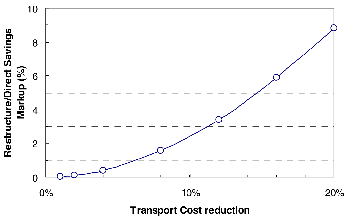
It is reasonable to expect that the mark-up factor will level off as transport cost reductions increase.
2. Trends in Freight Transportation
Based on the above, we now can see how improvements in freight transportation generate economic benefits that can improve the productivity of the national economy. In particular, an efficient and reliable freight system is a necessary condition for ensuring that transport costs remain low and foster increases in productivity. The following question remains, however: what affects the reliability and efficiency of the freight system?
In this Section, we will develop a picture of changes in the freight system and how well it has been performing—keeping in mind that the performance of the freight system is important since it not only affects economic productivity, but is itself a function of public policy. We will look briefly at the history of freight transportation since deregulation, recent trends in investment in freight transportation, especially highway freight, and consider the implications of investment trends.
2.1 Historic Perspective on Freight Transportation in the Post-deregulation Period
Changes in transportation and logistics, and especially changes in the trucking industry, came about as a consequence of trucking deregulation (Motor Carrier Act of 1980) and partial rail deregulation (Staggers Rail Act of 1980). Deregulation led to declines in trucking rates (see Exhibit 11), and, more importantly, a new, responsive, and flexible trucking industry emerged that has become more sophisticated in its operations and has made possible much of the improvement in the logistics system that has subsequently evolved.
Exhibit 11: Deregulation led to a decrease in trucking rates.
The fact that deregulation led to a striking decline in truck rates is shown below. After adjusting for inflation, revenue per truck-mile in 1999 was approximately 53% of the 1980 level. We see a similar pattern for rail rates. Revenue per ton-mile in 1998 was just over 44% of the figure for 1980.
The elimination of regulatory barriers to entry, and particularly the requirement for route and commodity-specific operating authority, permitted the rise of efficient truckload (TL) operations. Prior to deregulation, some TL firms existed, but the regulatory barriers kept them out of any significant markets. The less-than-truckload (LTL) firms were, for most practical purposes, the trucking industry. Insulated from competitive pressures, they generally offered one-size-fits-all service. There were no contracts for specific bundles of services and few arrangements for truckload pick-up and delivery at customer-specified times. And, of course, there was little door-to-door truckload service.
Things changed when TL carriers could approach shippers and offer door-to-door services, tailored to customer specifications, at rates much lower than those demanded by the LTL firms. It was this development that allowed guaranteed just-in time (JIT) deliveries and all the other features that brought the evolution of advanced logistics systems and supply-chain management (see Exhibit 12A). And, as we have seen, improvements in logistics generate business reorganization effects that help to enhance productivity.
More specifically, the phenomenon of lower freight rates and better service led to substitution of transportation spending for inventory spending. As shown in Exhibit 12B, actual spending on freight transport was rising much faster than inventory costs—businesses took advantage of cheaper and better freight transport to restrain growth in their inventory costs.
Exhibit 12A: The advent of TL carriers allowed for significant efficiency improvements in logistics systems.
The increased efficiency of the logistics system is manifest in the reduction of logistics cost as a share of Gross Domestic Product (GDP). Total logistics costs peaked as a share of GDP at 16.0 percent in 1981. By 1992 the share had dropped to 10.1 percent and has since remained close to that level over the last few years, being at 9.9 percent in 1999. This trend is shown in below.
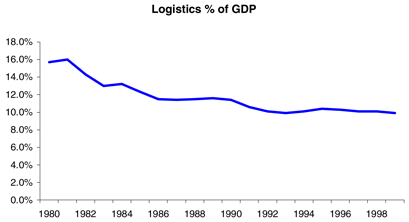
Exhibit 12B: Firms began to substitute transportation spending for inventory spending.
Relative to GDP, freight costs were at 7.4 percent in 1980 and have fallen since. Since 1988 the national freight bill has been an almost constant share, 6.1 or 6.0 percent, of GDP while the relative share of inventory costs has continued to fall—from a post-1980 high of 8.2 percent in 1981 to 3.6 percent in 1999.
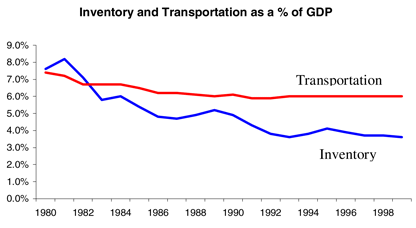
As businesses substituted transportation spending for inventory spending, and the business reorganization effect began to take a foothold, the demand for trucking services increased significantly. In particular, since 1990 (10 years post-deregulation) growth in trucking ton-miles has accelerated significantly (see Exhibit 13, below) and at a faster rate than GDP, but in line with growth rates in manufacturing.8
Exhibit 13: The demand for trucking services has grown rapidly in the 1990s, partly reflecting the business reorganization effect.
During the first decade following deregulation (1980 to 1990), intercity ton-miles grew at an average annual rate of 2.8 percent per year, somewhat slower than the 3.2 percent rate experienced during the pre-deregulation decade. Ton-miles between 1990 and 1998 grew at an annual rate of 4.3 percent, faster than GDP’s growth of 3.0 percent, but in line with manufacturing growth.
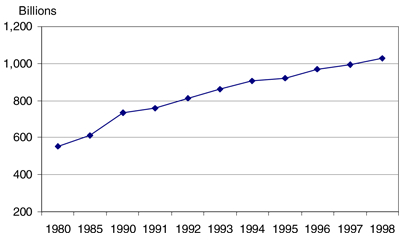
As with the development of TL carriers, the growth of intermodal rail traffic has improved the freight system’s efficiency. In 1980, the Interstate Commerce Commission exempted intermodal rail transport from all economic regulation without waiting for the Staggers Act. Railroads could quote whatever rates they thought best and were free to enter into contracts with customers. (Before 1980 contracts were not allowed.)
As a result, while total rail tonnage has grown slowly since 1980 (an average of 0.6 percent per year from 1980 to 1998), intermodal traffic (measured by number of trailers and containers moved by rail) has increased an average of 6.0 percent per year over the same period. The attraction of lower rail rates is part of the reason for this rapid growth. But the ability to develop contracts in which railroads could tailor service to the specific requirements of large customers was also important.
Intermodal freight transport has generated benefits that have further fostered productivity growth in manufacturing and the overall economy. For instance, the benefits of low-cost double-stack service were fully realized because the trans-Pacific container lines were able to contract with rail carriers for fast and reliable service—service that adheres to the precise schedules set by the steamship companies. Because of this, and because of competition between railroads, large volumes of imported consumer goods move speedily and reliably from West-coast ports to the Midwest at low rates (e.g., railroads are hauling containers from Los Angeles to Chicago at a rate of 30 cents a mile, while the average truckload rate is currently somewhat in excess of $1.00 a mile). Freight service of this quality and price allows major distributors and retailers to keep a tight rein on their logistics costs to the benefit of their customers and the overall economy.
TL carriers and intermodal transportation services exemplify the types of changes that have led to improvements in the reliability and quality of this nation’s freight system. As shippers have changed their logistics practices to take advantage of a more flexible and demand-responsive freight system, carriers have also improved their operations—as suggested by the development of TL and intermodal services. Improvements in trucking productivity, for example, are important to ensure that efficiency gains in the freight system are sustainable. So, how has productivity in the trucking industry fared since deregulation?
Exhibit 14 shows the recent trends in trucking labor productivity. The flattening, and even recent decline, in productivity suggests that the trucking industry may have difficulty in meeting short-term transportation demands from the manufacturing and service sectors over the next several years.9 If that occurs, productivity losses in the transportation sector can lead to higher intermediate costs to the manufacturing sector in the form of increased operating costs. This, in turn, can exert downward pressure on manufacturing productivity, as transportation and warehousing costs rise relative to output. In the longer term, decreases in manufacturing productivity result in an overall weakening of the U.S. economy.
Exhibit 14: Productivity Trends in the Trucking Industry
Based on available sources, labor productivity improved significantly from 1975 to the mid-1990s, but appears to have leveled off and may be possibly declining. The chart below presents two labor productivity indexes: one from the Bureau of Labor Statistics (BLS) and the other a calculation using ton-miles and BLS labor data.
Trends in Trucking Labor Productivity
2.2 Freight Productivity and System Performance
It is not entirely clear what has caused the slowdown in the productivity of the trucking industry. Labor productivity is affected by various factors including traffic congestion, the reliability of the transportation system, regulation (such as the hours of service rule and size and weight regulations), and the availability of qualified and experienced drivers or operators. However, although deregulation has led to important efficiency gains in carrier services and logistics practices, increasing traffic levels on our nation's highways may be beginning to take their toll on the productivity of the freight system (see Exhibit 15).
Exhibit 15: Growth in Truck Traffic
Growth in truck vehicle-miles accelerated in the 1990-1998 period by an average annual compound growth rate of 3.8 percent from 3.0 percent experienced during the 1980s. Combination truck vehicle-miles have grown at a faster rate than single-unit truck vehicle miles, reflecting an increasing average length of haul.
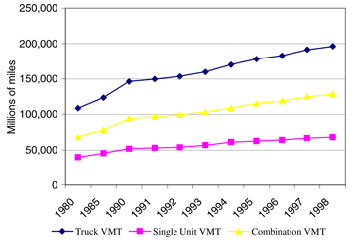
Even more striking is the fact that the share of truck VMT to total VMT has markedly increased in recent years. The share of truck VMT rose rapidly between 1993 and 1995 and appears to be leveling off at 7.5% of total highway VMT.
Share of Truck VMT

The impact of increasing traffic levels on the quality and reliability of freight transportation can be magnified if concomitant investments in our highways, ports, railroads, and intermodal facilities do not keep pace—in economics jargon, if the supply of infrastructure does not keep pace with increases in demand, the cost of moving freight will increase. Have we been investing enough on our nation’s highways to ensure that the productivity of the freight sector is maintained?
Exhibit 16A (below) shows the trend in highway investment since 1980, adjusted for inflation. The amounts shown are capital outlays on State-administered highways.10 The annual growth rate in investment over this period was 4.0 percent, compared to inflation-adjusted growth in GDP of 3.2 percent per year.11 Although capital outlays on highways have grown steadily since 1980 and outpaced growth in GDP, highway congestion has worsened significantly over this same period, as shown in Exhibit 16B.12
Exhibit 16A: Highway Investment Since 1980
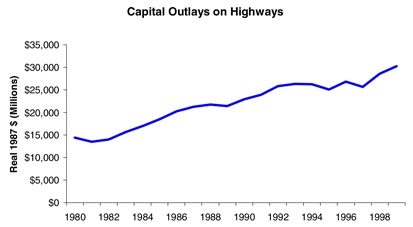
Travel Rate Congestion Index
Congestion has increased rapidly since 1980, as both passengers and freight compete to improve mobility and productivity.
Congestion is especially problematic for freight transportation. As noted earlier, evidence gathered in discussions with shippers and carriers indicates that shippers have been getting a high level of highway-freight service. Those shippers that demand it have obtained a high degree of schedule reliability (e.g., deliveries consistently arriving in time windows of 15 or fewer minutes even on runs of ten hours or longer). Whole systems of inventory control and supply-chain management have been built around the expectation that this kind of reliability is a permanent feature of freight service. Also, siting of warehouses and terminals has been based on current levels of speed and reliability on the highway network. All of these features of total logistics system are important for national productivity and welfare, and all could be threatened if the reliability of the highway system continues to deteriorate.13
Specifically, logistics costs are shown to be highly dependent on both transit time and transit time variability, which are directly affected by congestion. The sensitivity to transit times increases significantly for higher values of variability. The same can be said for service levels. The relationships between estimated total logistics costs and transit time and variability are illustrated in Exhibit 17 (below).
Non-recurrent, or unanticipated, congestion is even more problematic to the productivity of the freight transport system. Congestion contributes not only to making transit times longer, but also more unpredictable. This unpredictability can hinder JIT inventory management and even hinder some production processes. As a result, shippers attach a dollar value to predictability and speed. A study by HLB Decision-Economics indicated that carriers on average value savings in transit time at between $144 – $192 per hour. Savings in non-scheduled delay were valued at $371 per hour. In addition to value-of-time savings, there would also be vehicle operating cost savings from more efficient and reliable speeds. Although these results are based on a small sample, they indicate the magnitude of savings that can be generated by improving the performance of the highway system (which can be measured by congestion levels). It is interesting to note that time late was valued at roughly twice the rate of transit time.14
Exhibit 17: Minimum Logistics Cost Versus Transit Time for Various Levels of Reliability*

Lower logistics costs are achieved principally through smaller safety stocks. Improvements in achievable service levels are also made possible by a reliable and fast transportation system.
* Transit time reliability is expressed using the coefficient of variation CV. CV is defined as the ratio of the standard deviation to the mean.
Consequently, reduced transit time variability (which can be generated by decreases in congestion) allows for gains in scheduling and routing of transport resources. Increased competitiveness as a result of improved service levels may translate into higher sales and increased demand for both products and transport services.
2.3 Implications of Investment and Performance Trends
In commenting on the condition of the system, shippers and carriers tend to stress two themes. One is that they are, to a large degree, satisfied with the highway network as it now performs. They have designed their schedules and logistics systems around the current level of performance. But many of these people also emphasize that they would have a low level of tolerance for any deterioration in performance. For instance, there are choke points and problem areas, areas where speeds are markedly lower than in the rest of the country.
In the absence of improvements, the speed and reliability of the freight system can be expected to worsen as vehicle traffic grows and congestion increases. Such a development could force shippers and carriers into costly redesign and restructuring of their systems with higher logistics costs and a consequent drop in productivity. It is reasonable to suppose that, if such costs are to be minimized, the current level of investment must be, at least, maintained. However, improvement in the performance of the freight system, with concomitant gains in national productivity, will require gains in the battle against congestion.
Take, for example, the impact that congestion has on productivity growth stemming from information technology. Economic research is proving what has been suspected for a few years—that the sustained economic expansion of the late 1990s reflects a powerful link between information technology and the growth rate in U.S. productivity.15 The link is important because more than 80 percent of any improvement in people’s real incomes and living standards can come only from productivity growth.16 Productivity growth due to advanced logistics in the freight transportation sector is a microcosm of the IT revolution.
Exhibit 18 (below) illustrates how the relationship between IT-productivity growth in the economy at-large is mirrored in the freight transportation sector. Innovation in information technology facilitates development of new products in robotics, just-in-time inventory control programs, networked dispatching, real-time schedule management, and other manifestations of intelligent production and transportation logistics. When manufacturers and transportation firms invest in such products, their labor productivity improves (as proven by Stiroh) and peoples’ real wages improve accordingly. And, since capital investment itself triggers faster technological advance, a circle is established which drives the rate of growth higher still.17
Exhibit 18: The relationship between IT-productivity growth in the economy at-large is mirrored in the freight transportation sector.
But linkages can be weakened, even severed, by congestion and delay on the nation’s highways. It is one thing for new robotics and intelligent logistics products to come on the market; it is quite another for manufacturing and transportation firms to invest in them. Such investment is costly. Threats to the effectiveness of such products are threats to the business case for investing in them. Widespread testimonials are not at hand, but analytic and anecdotal evidence indicates that congestion and delay is viewed in some sectors as a barrier to obtaining satisfactory pay-back from investment in just-in-time logistical products. Take-up of advanced logistics may be waning already, in part due to the economic slowdown, but also to mounting congestion in some strategic corridors around the country.
3. Future Growth in Freight Transportation
As discussed in earlier sections of this report, an efficient and reliable freight transportation system helps to sustain growth in economic productivity. However, recent trends in the performance of the highway system, as measured by congestion and system reliability, likely have adversely impacted the system's productivity. As congestion has worsened, system reliability has been compromised. Moreover, decreases in carrier productivity, can lead to increases in the relative cost of moving goods, dampening growth in the economy.
It can be argued that the problems that are generated by congestion will be difficult to mitigate because of projected growth in the demand for highway travel and concomitant constraints in the development of additional highway infrastructure (e.g., constraints stemming from funding availability, environmental considerations, community opposition, etc.). For instance, the Federal Highway Administration (FHWA) estimates that by 2020 freight volume in the US will nearly double in some sectors (see Exhibit 19). Consequently, maintaining (not to mention improving) the productivity of our freight transportation system will be challenging.
Exhibit 19: According to a recent FHWA presentation, US domestic freight traffic is expected to grow by 2.9 percent by 2020. “Freight Trends/Issues, Multimodal System Flows and Forecasts, and Policy Implications” shows that US domestic freight will rise by 3.4 percent between 1998 and 2010, and another 2.4 percent from 2010 to 2020. US international freight traffic is expected to grow by 3.4 percent between 1998 and 2020, including an increase of US/Canada traffic by 3.1 percent, US/Mexico traffic by 3.5 percent. In 1998, domestic and international US freight traffic totaled approximately 9.8 billion tons and $9.1 trillion
The private sector’s ability to generate the types of economic benefits that stem from productivity increases depends on how well our transportation facilities are maintained, operated, or expanded (for highways, these activities fall predominantly within the responsibility of the public sector). Likewise, through regulation and investment decisions, public policy affects the manner in which shippers and carriers operate and make logistics decisions.
However, transportation policy and planning is not as robust as it should be in relation to the freight sector. For instance, project analysis tools do not appropriately recognize how and why infrastructure design and capacity problems drive down the productivity of freight transportation and drive up the cost of industrial production. Likewise, transportation planners and decision-makers cannot anticipate readily how infrastructure improvements would make freight carriers, their industrial customers, and the economy at large better off. With a significant portion of the focus of transportation policy and planning shifting to freight-related matters, filling the planning gap is essential.
Clearly, highway investments that increase capacity and/or speed and reduce accidents will improve the performance of trucks, as will improvements in operations planning. Improvements in intermodal connections will also have an effect. Furthermore, Intelligent Transportation Systems (ITS) can be particularly important, especially when they reduce incident-based congestion. It is clear that transportation agencies at all levels of government can bring about improvement in highway freight-carriage. For instance,
- Targeted capacity expansion projects that alleviate high-frequency bottlenecks in the freight system can improve transit time variability.
- Freight planning can help to make sure that freight movement needs are appropriately considered by decision-makers by providing state and local transportation planners with the necessary tools to better account for the impacts of alternative investments on the efficiency of the freight system.
- Programs that strive to improve operations planning (or the interaction of planning and operations functions within a transportation agency) can improve system performance.
- ITS deployment can enhance the efficiency of the highway system through operational improvements, better user information, and incident management (which is particularly problematic from the perspective of system reliability).
- Federal grant programs that provide financing mechanisms for freight transportation improvements can help to generate the types of investments needed to improve the productivity of the freight system.
In a nutshell, future (and to some extent current) challenges will center on 1) squeezing as much efficiency as possible out of available transportation resources (in particular infrastructure) and 2) finding scarce resources to implement efficiency-enhancing programs and projects.
1 Readers interested in obtaining copies of the various reports that have been developed (to date) under FHWA's Freight BCA Study can visit http://www.ops.fhwa.dot.gov/freight/.
2 Generative effects are those that increase income by using resources more effectively and/or by using resources previously underutilized.
3 In general, the sponsors and authors of these models have been heavily focused on user benefits for highway passengers and have not given thorough consideration to the economics of freight movement. In the standard models, the treatment of trucks is parallel to that of passenger cars. Benefits are reckoned on the basis of reduced travel time, reduced operating costs, and reduced costs from accidents, all in terms of benefit to the owner of the truck.
4 Carrier effects include reduced vehicle operating times and reduced costs through optimal routing and fleet configuration. Transit times may affect shipper in-transit costs such as for spoilage, and scheduling costs such as for inter-modal transfer delays and port clearance. These effects are non-linear and may vary by commodity and mode of transport.
5 Improvements include rationalized inventory, stock location, network, and service levels for shippers.
6 In the first-order case, nothing changes for shippers except the cost of freight movement (including time cost). They continue to ship the same volume of goods the same distance between the same points. Their costs are less, but they make no response to the cost reduction other than to keep the extra income thus realized. In order to estimate the first-order benefits, it is necessary to find the value of the time-cost reductions and then add this amount to those that are calculated in a standard analysis—reductions in operating costs, cost savings from reductions in accidents, and drivers’ wages—all assuming no change in volumes or distances shipped.
In the second-order case, firms respond to the cost reduction. They may reduce prices to gain additional revenue by selling more goods; they may ship longer distances; they may close some warehouses; they may do some combinations of these things; or they may do something else altogether. Cost reductions of a certain magnitude occur; firms respond in ways that lead to both greater output and lower cost per unit of output.
7 Note that, as shown in “Benefit-Cost Analysis of Highway Improvements in Relation to Freight Transportation: Microeconomic Framework”, this captures all benefits without double counting.
8 The following table shows the annual growth in ton-miles compared with manufacturing growth. The two growth rates are virtually the same over the period 1980-1998. It should be noted, however, that, in the last few years, growth in highway freight ton-miles has fallen somewhat below growth in manufacturing output.
| 1980-1990 | 1990-1998 | |
|---|---|---|
| Annual Growth in Intercity Trucking Ton-Miles | 2.8% | 2.8% |
| Annual Growth in Manufacturing | 2.7% | 2.8% |
Longer truck hauls (which partly determine ton-mileage) reflect, in part, the greater “reach” of factories and warehouses as businesses have reorganized and optimized their logistics arrangement in light of improved performance of the freight system. On the other hand, lighter products and packing materials may have restrained the growth of tonnage relative to production. This explains why trucking ton-miles has not grown at a faster rate than manufacturing output.
9 Note that it is possible that quality improvements (e.g., on-time performance) are not fully reflected in the BLS measure for labor productivity. That measures uses inflation-adjusted revenue as the measure of trucking output
Although there has been a recent decline, capital (equipment) utilization has also improved since deregulation. The average length of haul has increased and the number of trips made by the average tractor-trailer combination has also increased over the last two decades. More trips, and more miles per trip, means the average combination vehicle is moving more ton-miles.
10 State roads were chosen so as to leave out the local network that is less important for line-haul freight movement.
11 In this same period, railroad capital expenditures grew relatively slowly, at an annual rate of 1.0 percent after adjusting for inflation. This is slightly faster than the growth of rail tonnage in the same period (0.6 percent per year).
12 The TTI travel rate congestion index measures how much longer it takes you to make trip in a congested peak travel period (e.g., 8AM or 9AM) compared to an uncongested off-peak period (e.g., midday or late night). In 1982, it took about 20 percent more time to make a trip in a very large metropolitan area during the peak period. In 1997, it took over 40 percent more time.
13 Note that the share of truck VMT to total VMT on the nation's highways has increased markedly in recent years. Consequently, increases in delay resulting from congestion have had an increasing impact on the productivity of trucking.
14 The value of direct time savings in freight transportation provides a lower bound for the overall value of such time savings from a total logistics perspective. As a logistics input, transportation efficiency gains might alter the optimal balance between inventory holdings, warehousing and transportation. In the long run, some firms may be able to utilize improved transportation delivery to reduce safety stocks, improve service levels and lessen warehousing needs. A business reorganization effect could reduce total logistics costs well beyond the value of direct time savings.
15 Kevin J. Stiroh of the Federal Reserve Bank of New York reports that IT-intensive industries experience significantly larger productivity gains than other industries and a wide variety of his econometric tests show a strong correlation between IT capital deepening and productivity growth. Stiroh’s results indicate that virtually all of the aggregate productivity acceleration of the late 90s is due to industries that either produce IT or use it intensively, with essentially no contribution from industries that are less involved in the IT revolution. From Information Technology and the U.S. Productivity Revival: What Do the Industry Data Say? Federal Reserve Bank of New York, January 12, 2001
16 Dale W. Jorgenson, Information Technology and the U.S. Economy, The American Economic Review, March 2001
17 David Lewis, The Role of Public Infrastructure in the 21st Century, Special Report 220, Transportation Research Board, National Research Council, 1988
previous | next
